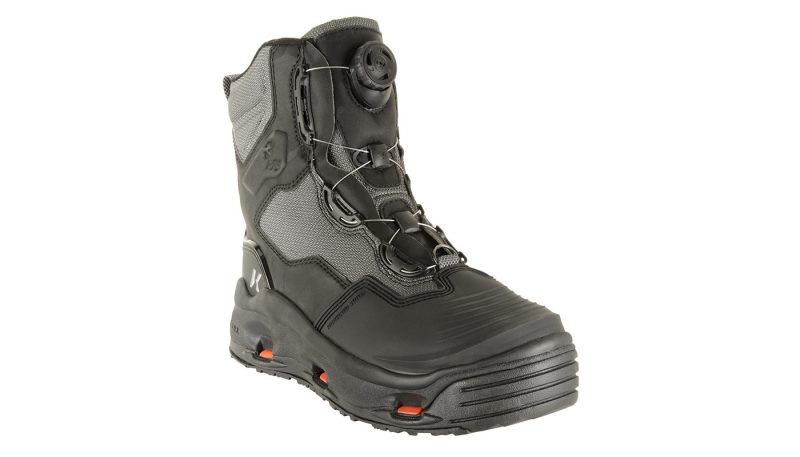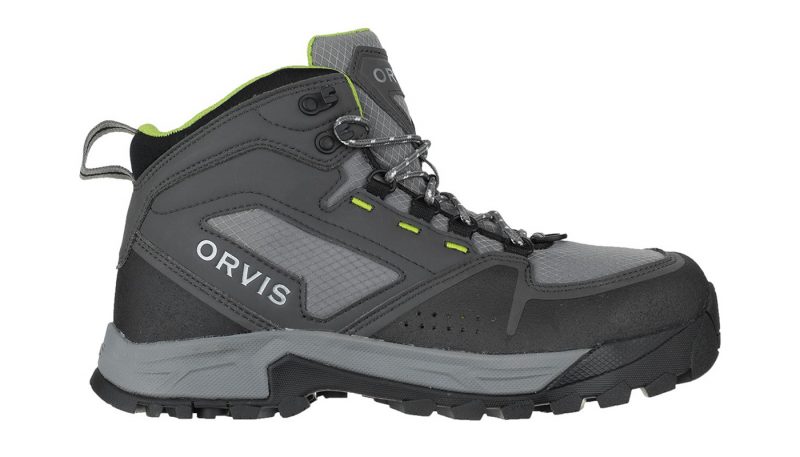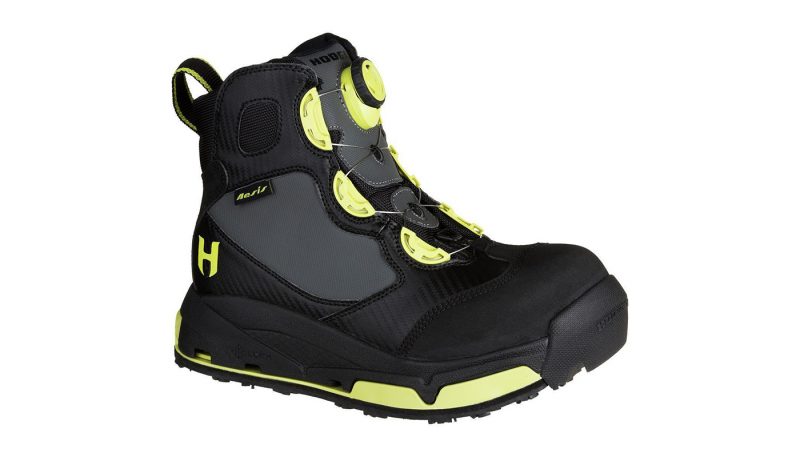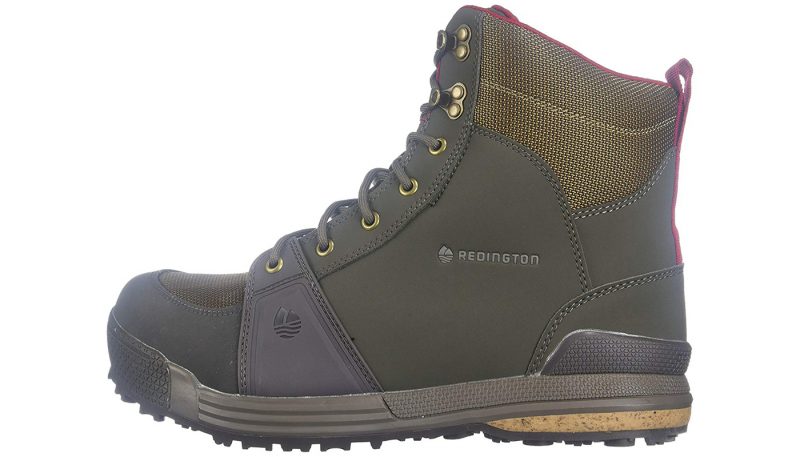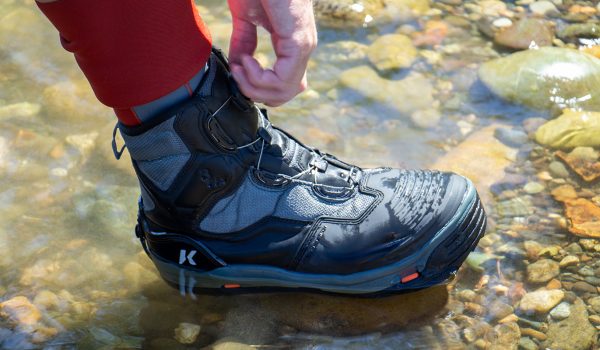The use of rubber in place of felt soles has become more common with the increasing concern over the transfer of invasive aquatic species such as ‘rock snot’ (didymosphenia geminate) – a slimy growth that can restrict the populations of aquatic insects upon which trout feed – that can hide within the porous felt soles. But while some states and National Parks have banned the use of felt-soled boots, the fabric soles still provide the ultimate in traction on slimy river rocks.
This year, we asked manufacturers to provide the choice of best boot, and most chose to send rubber soled models – or models with interchangeable soles. That seems to be an increasingly popular choice, as anglers can match their soles to their fishing environments without having to carry multiple pairs of boots. Of the models we tested, half featured interchangeable soles.

Fit
The Orvis Ultralight Wading Boots offer the best hiking boot-style fit, with a narrow heel cup and a roomy toe box to ensure a locked-in fit while walking with toe compression. The Ultralights held firm on the foot even when climbing steep canyon walls or sliding down muddy embankments to a river. Korkers also provided a comfortable fit, with solid support of the ankle and lower leg. The boots fit comfortably over bulky wader boots without slop or slipping. A good part of the fit comes as a result of the Boa lacing system. This system uses a steel cable looped through a series of laces and wound on a knob-driven reel. Redington’s Prowlers sport a looser fit that’s not ideal for long hikes but is perfectly suited for use with heavy wader booties and thick, warm socks. The only really marginal fit we found was on the Hodgman Aesis H-Lock. This loose-fitting boot was able to accommodate bulky wader booties and extra socks for warmth, but the boots were a bit too loose when paired with summer-weight waders/booties and thin socks.
Grip
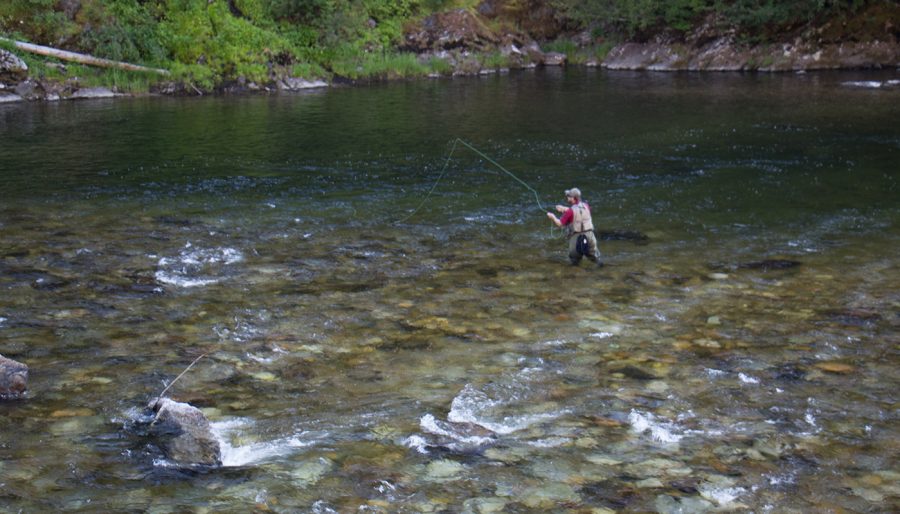 With the option of three different soles, which can be changed on the fly, the Korker Darkhorses dominated the traction category. The Darkhorse proved to be the most efficient in grip and traction, regardless of the environmental conditions being encountered. The felt soles provide exceptional grip in rock-lined rivers. The felt cuts through rock slime better than any other sole material, giving firm traction in greasy conditions. When having to spend more time hiking to fishable water, and scrambling around dry riverbanks and trails, the steel-studded rubber outsoles give a firm bite for solid footing in and out of the water. And when fishing from rafts or drift boats, the unstudded rubber soles provide the best option — good grip on boats without the risk of damage from metal studs. Like the Korkers, Hodgman’s Aesis H-Lock boots provide solid traction in a variety of conditions, thanks to their version of an interchangeable sole. Orvis’ Ultralight Wading Boot, using a sticky Vibram rubber outsole, proved remarkably grippy on slick river rocks, and provided exceptional traction on trails and steep river banks. Redington’s sticky rubber outsoles did not perform as well as the Orvis Ultralight when it came to river traction, but the grip was good enough to earn grudging respect from one felt-loving tester who deemed them nearly as secure as felt on most wet rocks and much better than felt out of the water.
With the option of three different soles, which can be changed on the fly, the Korker Darkhorses dominated the traction category. The Darkhorse proved to be the most efficient in grip and traction, regardless of the environmental conditions being encountered. The felt soles provide exceptional grip in rock-lined rivers. The felt cuts through rock slime better than any other sole material, giving firm traction in greasy conditions. When having to spend more time hiking to fishable water, and scrambling around dry riverbanks and trails, the steel-studded rubber outsoles give a firm bite for solid footing in and out of the water. And when fishing from rafts or drift boats, the unstudded rubber soles provide the best option — good grip on boats without the risk of damage from metal studs. Like the Korkers, Hodgman’s Aesis H-Lock boots provide solid traction in a variety of conditions, thanks to their version of an interchangeable sole. Orvis’ Ultralight Wading Boot, using a sticky Vibram rubber outsole, proved remarkably grippy on slick river rocks, and provided exceptional traction on trails and steep river banks. Redington’s sticky rubber outsoles did not perform as well as the Orvis Ultralight when it came to river traction, but the grip was good enough to earn grudging respect from one felt-loving tester who deemed them nearly as secure as felt on most wet rocks and much better than felt out of the water.
Weight
When considering weight, we looked at both the dry out-of-box measured weight, and the effective weight in the field. That is, we checked the ability of the boots to shed water rather than carrying it as added weight after leaving a river. In both cases, the Orvis Ultralight excelled. At just over a pound and a half per boot (size 13!), the Ultralights are heavier than similarly sized hiking boots but are much lighter than any other wading boot in the class. The polyester mesh and polyurethane-coated nylon fabric in the upper shed water rapidly, thus helping keep weight down during use by drying quickly. The Hodgman Aesis, with its roomy interior and lack of adequate drainage holes, held the most water weight, and they weighed more than any other boot in the class out of the box. Korker’s Darkhorse and Redington’s Prowler both shed water well, though the Prowlers were a bit more efficient than the Darkhorse. On the other hand, the Prowlers weigh more out of the box than the Darkhorse, so at the end of the day, their weight ratings were very similar.
Treadlife
Considered practically, the boots with interchangeable soles offer the greatest tread life, such use can be distributed between two or three separate soles. That theory proved true in this test, with the Korker Darkhouse providing the best wear in the class. The Hodgman Aesis felt short of the Korker’s performance, due to thinner, less-dense felt and softer rubber. Orvis’ use of soft, sticky Vibram Rubber proved very grippy but also was quick to wear down, giving them the shortest Treadlife in the class. Redington’s rubber soles are a bit stiffer and therefore have a longer life.
Durability
The Hodgman Aesis H-Lock boots offered good general durability in all but the base of the boot. The H-Lock interchange system worked well when clean and dry, but once the boots had been worn through mud, sand, and gravel, some issues developed. Grit infiltrated the system and made removal and replacement difficult and raised questions about the long-term durability of that system. Korkers had fewer issues with clogging of their system, and the Korkers Uppers proved incredibly stout and durable. The clean design of the Redington Prowlers minimized snagging and abrasion even when scrambling through tightly jumbled rocks. The material of the uppers proved tough and the construction held up well to rough use. The Prowlers held up better than any other boot in this class. Aside from the limited life of the soles, the Orvis Ultralights sport a tough durability belied by their lightweight nature.
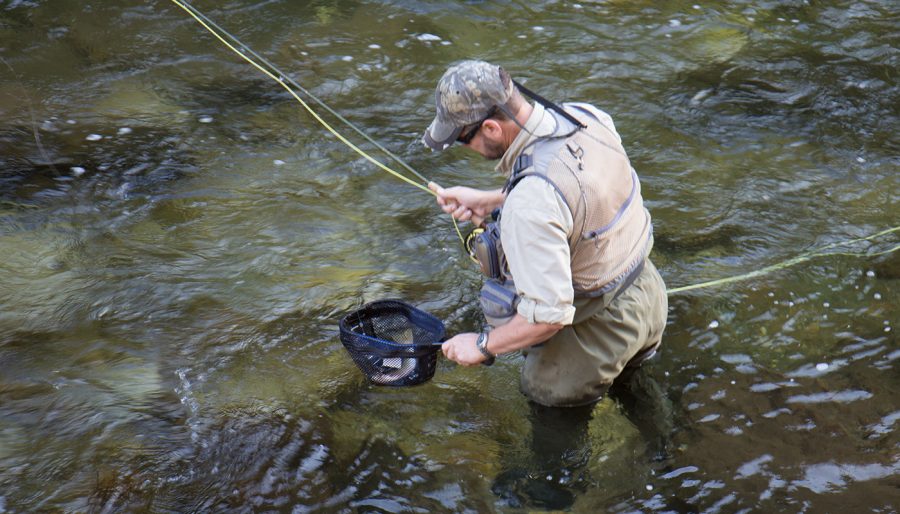
Review Conclusion
By consensus opinion, the Korkers Darkhorse earned the Best in Class Honors for 2018 in Men’s Wading Boots. The Darkhorse’s interchangeable soles, comfortable fit, and solid support and durability made them ideal for just about any angling adventure. The Orvis Ultralights earned high praise, too, and were deemed the ideal wading boot for travel and road trips. Their weight and size making packing them on planes easy, and their non-felt soles are suitable for use anywhere, even in regions with tight restrictions designed to reduce the risk of transporting invasion species.
Methods
For this year’s test, our team took out the latest products from several different brands into a variety of environments and conditions. We hiked miles into wilderness river locations. We fished off the pebbly beaches of Puget Sound and the North Pacific coast. We waded into spring creeks in eastern Washington and southern Idaho, and fished off boats and off the banks on rivers in Montana, Wyoming, Oregon, Colorado, Idaho, and Washington.
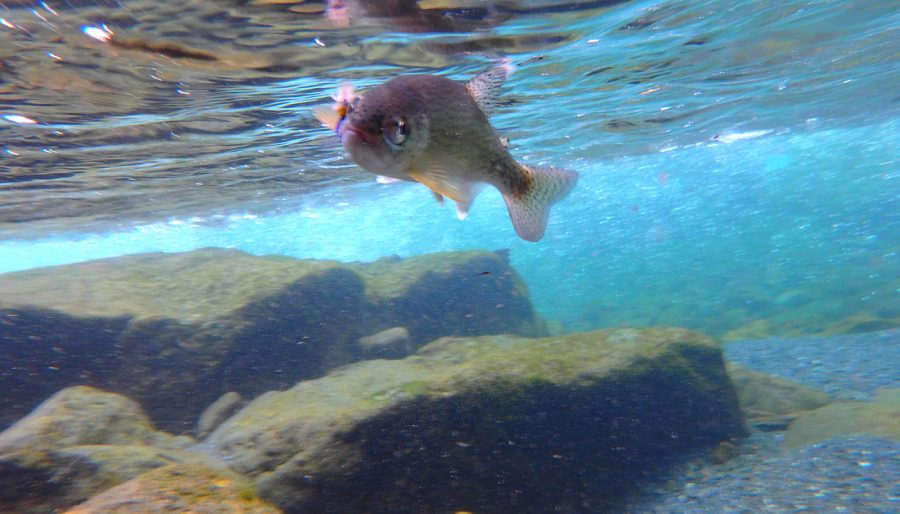
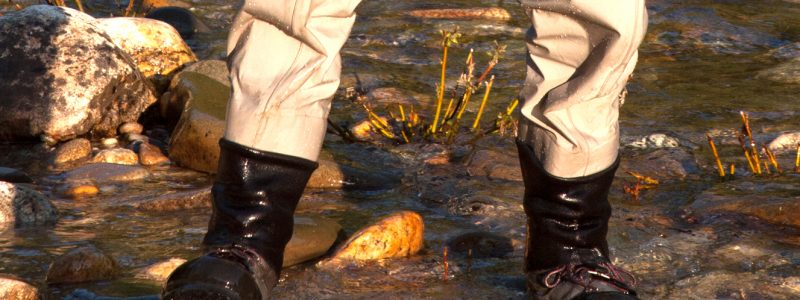

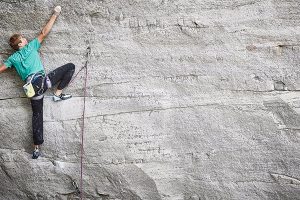
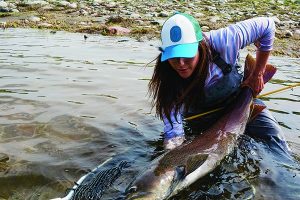

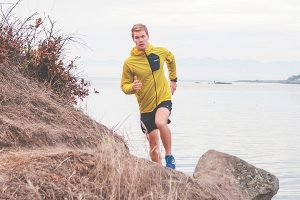




 With the option of three different soles, which can be changed on the fly, the Korker Darkhorses dominated the traction category. The Darkhorse proved to be the most efficient in grip and traction, regardless of the environmental conditions being encountered. The felt soles provide exceptional grip in rock-lined rivers. The felt cuts through rock slime better than any other sole material, giving firm traction in greasy conditions. When having to spend more time hiking to fishable water, and scrambling around dry riverbanks and trails, the steel-studded rubber outsoles give a firm bite for solid footing in and out of the water. And when fishing from rafts or drift boats, the unstudded rubber soles provide the best option — good grip on boats without the risk of damage from metal studs. Like the Korkers, Hodgman’s Aesis H-Lock boots provide solid traction in a variety of conditions, thanks to their version of an interchangeable sole. Orvis’ Ultralight Wading Boot, using a sticky Vibram rubber outsole, proved remarkably grippy on slick river rocks, and provided exceptional traction on trails and steep river banks. Redington’s sticky rubber outsoles did not perform as well as the Orvis Ultralight when it came to river traction, but the grip was good enough to earn grudging respect from one felt-loving tester who deemed them nearly as secure as felt on most wet rocks and much better than felt out of the water.
With the option of three different soles, which can be changed on the fly, the Korker Darkhorses dominated the traction category. The Darkhorse proved to be the most efficient in grip and traction, regardless of the environmental conditions being encountered. The felt soles provide exceptional grip in rock-lined rivers. The felt cuts through rock slime better than any other sole material, giving firm traction in greasy conditions. When having to spend more time hiking to fishable water, and scrambling around dry riverbanks and trails, the steel-studded rubber outsoles give a firm bite for solid footing in and out of the water. And when fishing from rafts or drift boats, the unstudded rubber soles provide the best option — good grip on boats without the risk of damage from metal studs. Like the Korkers, Hodgman’s Aesis H-Lock boots provide solid traction in a variety of conditions, thanks to their version of an interchangeable sole. Orvis’ Ultralight Wading Boot, using a sticky Vibram rubber outsole, proved remarkably grippy on slick river rocks, and provided exceptional traction on trails and steep river banks. Redington’s sticky rubber outsoles did not perform as well as the Orvis Ultralight when it came to river traction, but the grip was good enough to earn grudging respect from one felt-loving tester who deemed them nearly as secure as felt on most wet rocks and much better than felt out of the water.

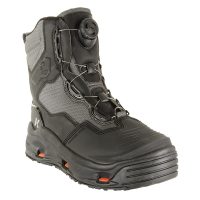
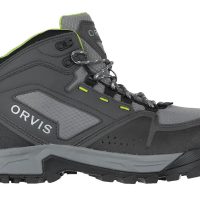

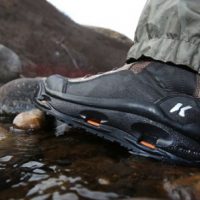
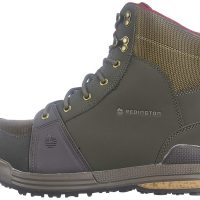
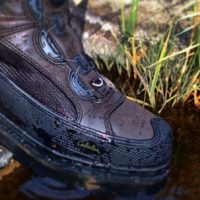
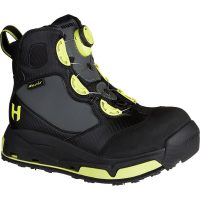
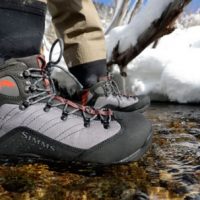
 88
88 